
In today’s Claire Chats I look at Richard Edwards: who he was and how he has become linked to Henry VIII.
[Read More...]
In today’s Claire Chats I look at Richard Edwards: who he was and how he has become linked to Henry VIII.
[Read More...]
A video answering the question “would Richard III’s spinal deformity have prevented him from leading the charge at the Battle of Bosworth?”
[Read More...]
Isotope analysis of bone and tooth material from the remains of Richard III has revealed that the king enjoyed large amounts of wine along with freshwater fish, egret, swan, heron and crane.
[Read More...]
On this day in history, 13th March 1619, the stage lost one of its greatest stars. Richard Burbage, Shakespeare’s leading man, the original Hamlet, Othello, and King Lear, breathed his last at the age of fifty.
But Burbage wasn’t just an actor. He was a theatre pioneer, a close friend of Shakespeare, and a man whose talent defined the golden age of English drama.
So, who was he?
Richard Burbage was born in 1568, baptised in London’s St. Stephen’s Church on 7th July. His father, James Burbage, was an actor and entrepreneur, and young Richard grew up surrounded by the world of performance.
[Read More...]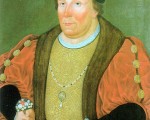
What happens when ambition, power, and royal paranoia collide? Edward Stafford, Duke of Buckingham, was one of the wealthiest and most influential men in Tudor England—a man with royal blood and a life of privilege. But his story ends with betrayal, scandal, and a rigged trial.
Was he a victim of Henry VIII’s fear of rivals, or was there truth to the charges against him?
Edward Stafford was born on this day in Tudor history, 3rd February 1478, at Brecon Castle, a member of the powerful Stafford family. His father, the 2nd Duke of Buckingham, had rebelled against Richard III and paid the ultimate price—execution in 1483. Young Edward’s life began in turmoil, but it seemed his fortunes would improve when Henry VII came to the throne in 1485.
[Read More...]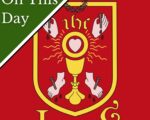
On this day in Tudor history, 9th October 1536, in the reign of King Henry VIII, the rebels of Horncastle, Lincoln, dispatched their petition of grievances to the king and also north into Yorkshire.
These were the rebels of the Pilgrimage of Grace rebellion, an uprising in the north of England which was sparked off initially by trouble in Lincolnshire. This trouble, in turn, was caused by discontent over the dissolution of Louth Abbey, the government commissions in the area and rumours that these commissions would confiscate jewels and plate from churches and impose new taxes.
[Read More...]
On this day in Tudor history, 15th May 1536, the trials of Queen Anne Boleyn and her brother, George Boleyn, Lord Rochford, took place at the Tower of London.
Unsurprisingly, they were both found guilty of committing incest and plotting to kill the king, and sentenced to death – see video below. But there was some humiliation for the king when George was handed a note about his sister talking to his wife, Jane Boleyn, Lady Rochford, about the king’s lack of sexual prowess.
[Read More...]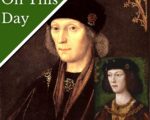
On this day in Tudor history, 21st April 1509 fifty-two-year-old Henry VII died, leaving the throne to his seventeen-year-old son, also called Henry.
Henry VII had ruled for over 23 years, since defeating King Richard III at the Battle of Bosworth in 1485.
The accession of Henry VIII, who was a good-looking and athletic young man of 6’3, was greeted with rejoicing. He seemed to be the ideal Renaissance Prince.
[Read More...]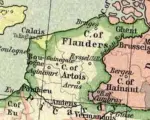
On 10th April 1540, priest Sir William Peterson, former commissary of the Archbishop of Canterbury in Calais, and William Richardson, priest of St Mary’s in Calais, were hanged, drawn and quartered in the marketplace at Calais for denying Henry VIII’s supremacy.
In his article “Martyrdoms at Calais in 1540?”, Rev. L.E. Whatmore writes of how from 1525, Sir William Peterson was “the most important priest in Calais” because of his “double capacity” as “the Archbishop’s and the Cardinal’s representative” in Calais. 1532 saw the death of William Warham, Archbishop of Canterbury, who was replaced by Thomas Cranmer. Peterson continued in his office under Cranmer and in September of that year was also appointed rector of Bonynges in the Calais Marches.
[Read More...]
On this day in Tudor history, 13th March 1619, actor and star of Shakespeare’s Lord Chamberlain’s Men and the King’s Men, Richard Burbage, died aged fifty.
Burbage performed with William Shakespeare and is named in Shakespeare’s will of 1616 as a “fellow”, meaning a close friend or colleague.
Let me give you a few facts about this Elizabethan actor…
[Read More...]
On this day in Tudor history, 8 March 1569, evangelical reformer and Member of Parliament Richard Tracy died at his manor in Stanway, Gloucestershire.
Tracy was the cousin of Protestant martyr James Bainham and his works included the 1543 pamphlet on justification by faith: “Profe and Declaration of thys Proposition: Fayth only iustifieth”, which was dedicated to Henry VIII; the 1544 “‘A Supplycation to our most Soueraigne Lorde, Kynge Henry the Eyght” and “A Bryef and short Declaracyon made wherebye euery Chrysten Man may knowe what is a Sacrament”. In Elizabeth I’s reign, he served as a Commissioner of the Peace and Sheriff in Gloucestershire.
[Read More...]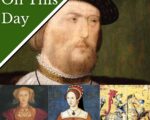
On this day in Tudor history, 19th January 1561, in the reign of Queen Elizabeth I, Sir Edward Carne died in Rome. He was about sixty-five years of age.
The administrator and diplomat, who came from Glamorgan in Wales originally, carried out diplomatic missions for King Henry VIII, was a royal commissioner during the dissolution of the monasteries, negotiated for a fourth marriage for Henry VIII after the death of Jane Seymour, was Mary I’s English ambassador to Rome, and claimed descent from the Kings of Gwent! An interesting man.
[Read More...]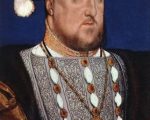
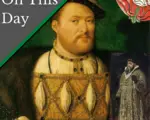
On this day in Tudor history, 10th May 1533, the Great Matter, Henry VIII’s quest for an annulment of his marriage to Catherine of Aragon, neared its conclusion.
Find out what happened on this day in 1533, and what happened next…
[Read More...]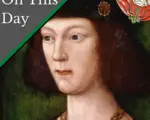
The king is dead! Long live the king!
On this day in Tudor history, 21st April 1509, the founder of the Tudor dynasty, King Henry VII, died at Richmond Palace. He had ruled since 1485, when his forces defeated those of King Richard III at the Battle of Bosworth.
Henry VII was succeeded by his seventeen-year-old son, Henry, who, it was said, did “not desire gold or gems or precious metals, but virtue, glory, immortality”!
[Read More...]
Glastonbury Abbey in Tudor times was a majestic powerhouse of monastic prayer. Learn all about Abbot Richard Whiting
[Read More...]
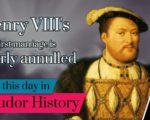
On this day in Tudor history, 10th May 1533, the Great Matter, Henry VIII’s quest for an annulment of his marriage to Catherine of Aragon, neared its conclusion.
Find out what happened on this day in 1533, and what happened next…
[Read More...]
Richard Neville was the son of Sir Henry Neville who died at Edgcote in July of 1469 and his wife Joan, daughter of John Bourchier, 1st Baron Berners. He is an interesting Tudor figure because he saw the beginning of the reign of Henry VII, being part of the War of the Roses and lived up until Henry VIII’s ‘Great Matter.’
Richard Neville inherited his title and lands when just a baby in 1469, the principal seat being Snape Castle in Richmondshire, following his grandfather George Neville’s death. However, his great uncle, Thomas Bourchier, who was a cardinal and later Archbishop of Canterbury, purchased the wardship of Richard and his marriage in May 1470 for £1000. Still, Richard’s lands remained the property of the crown. Not much is known about the early life of Richard Neville, but we do know that he was knighted in January 1478.
[Read More...]
On this day in Tudor history, 2nd October 1514, eighteen-year-old Mary Tudor, sister of King Henry VIII, set off from Dover to sail to France to marry fifty-two-year-old King Louis XII of France.
Things hadn’t gone to plan with the scheduled sailing, due to bad weather, and Mary encountered rough seas on her journey too.
Find out about the arrangements for the journey, who was at Dover, Mary’s crossing to Boulogne, and what happened next, in today’s talk.
[Read More...]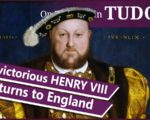
On this day in Tudor history, 30th September 1544, fifty-three-year-old King Henry VIII returned to England after his third invasion of France and the French surrender of Boulogne to him and his troops.
Hear a contemporary account of what happened during the siege of Boulogne and how and why the French surrendered to Henry VIII, in today’s talk.
[Read More...]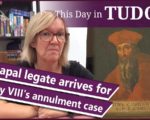
On this day in Tudor history, 29th September 1528, the papal legate, Cardinal Lorenzo Campeggio, landed at Dover on the Kent coast.
Campeggio and Cardinal Thomas Wolsey, who had been appointed the pope’s vice-regent, were given the task of hearing Henry VIII’s case for an annulment of his marriage to Catherine of Aragon.
Find out more about what happened when next, what happened at the special legatine court, and how Henry ended up waiting for his annulment for a few more years, in today’s talk.
[Read More...]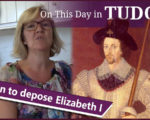
On this day in Tudor history, 24th July 1553, merchant and conspirator Richard Hesketh was born in Lancashire. Hesketh is known for the Hesketh Plot of 1593, when he urged Ferdinando Stanley, 5th Earl of Derby, to lead a rebellion to claim the throne of England.
But who was Richard Hesketh and why did he plot against Queen Elizabeth I? What happened to him and what happened to Ferdinando Stanley? And why did Stanley take bezoar stone and uncorn horn?
Find out all about Hesketh, his background, his plot, and the aftermath in today’s talk.
[Read More...]
On this day in Tudor history, 14th July 1575, evangelical reformer and translator, Richard Taverner, died at Woodeaton in Oxfordshire. He was laid to rest in the parish church at Woodeaton.
Richard Taverner is mainly known for his Bible translation, “Taverner’s Bible”, but there is far more to him than that, including his time as Thomas Cromwell’s chief propagandist.
Find out all about Richard Taverner’s life and career in today’s talk.
[Read More...]
On this day in Tudor history, 25th June 1503, the nearly twelve-year-old Henry, Prince of Wales, eldest surviving son of King Henry VII, got betrothed to seventeen-year-old Catherine of Aragon at the Bishop of Salisbury’s palace in Fleet Street, London.
But why did it take them until 1509 to get married? What happened?
Find out about their betrothal and their subsequent break-up in today’s talk.
[Read More...]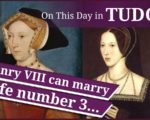
On this day in Tudor history, 19th May 1536, Queen Anne Boleyn was executed within the confines of the Tower of London.
It must have been an incredibly hard day for the queen’s friend, Archbishop Thomas Cranmer. Not only did he have a visit from a friend regarding a terrifying vision, in the early hours… Not only did he have to cope with the idea of his friend and patron being beheaded, but he had to issue a dispensation for the king to marry again!
Find out more in today’s talk.
[Read More...]
On this day in history, 16th March 1619, actor Richard Burbage was buried at St Leonard’s Church, Shoreditch.
Burbage was a famous actor in the reigns of Queen Elizabeth I and King James I, peforming for royalty and even being in King James’ company of players. Burbage was also a good friend of William Shakespeare, and the two men were involved in the building of the famous Globe Theatre.
Find out more about Richard Burbage, his life and career, in today’s talk.
[Read More...]

On this day in Tudor history, 5th January 1546, in the reign of King Henry VIII, geographer and poet, Richard Willes, was born in Pulham, Dorset.
Richard Willes has been described as “One of the quirkier figures in the literary history not only of the college but of the Elizabethan period as a whole”, and he certainly was an interesting Tudor man. Find out about his literary accomplishments, and what exactly made him so “quirky”, in today’s talk.
[Read More...]